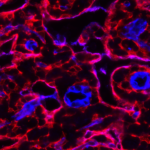Link to Pubmed [PMID] – 25576923
Oncotarget 2015 Feb;6(5):2779-93
We used whole genome microarray analysis to identify potential candidate genes with differential expression in BRAFV600E vs NRASQ61R melanoma cells. We selected, for comparison, a peculiar model based on melanoma clones, isolated from a single tumor characterized by mutually exclusive expression of BRAFV600E and NRASQ61R in different cells. This effort led us to identify two genes, SEMA6A and MICAL1, highly expressed in BRAF-mutant vs NRAS-mutant clones. Real-time PCR, Western blot and immunohistochemistry confirmed preferential expression of Sema6A and Mical1 in BRAFV600E melanoma. Sema6A is a member of the semaphorin family, and it complexes with the plexins to regulate actin cytoskeleton, motility and cell proliferation. Silencing of Sema6A in BRAF-mutant cells caused cytoskeletal remodeling, and loss of stress fibers, that in turn induced cell death. Furthermore, Sema6A depletion caused loss of anchorage-independent growth, inhibition of chemotaxis and invasion. Forced Sema6A overexpression, in NRASQ61R clones, induced anchorage-independent growth, and a significant increase of invasiveness. Mical1, that links Sema/PlexinA signaling, is also a negative regulator of apoptosis. Indeed, Mical-1 depletion in BRAF mutant cells restored MST-1-dependent NDR phosphorylation and promoted a rapid and massive NDR-dependent apoptosis. Overall, our data suggest that Sema6A and Mical1 may represent new potential therapeutic targets in BRAFV600E melanoma.

